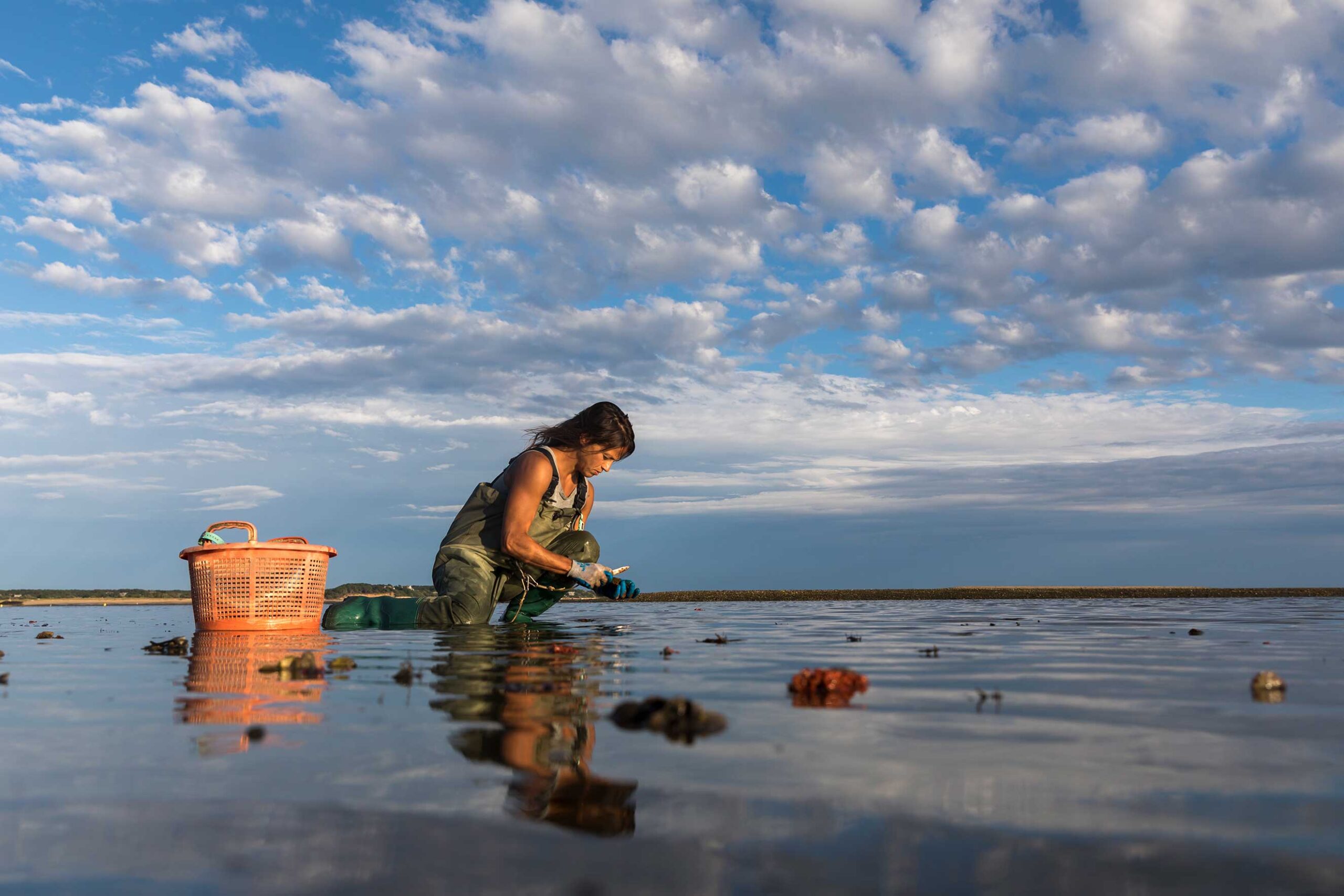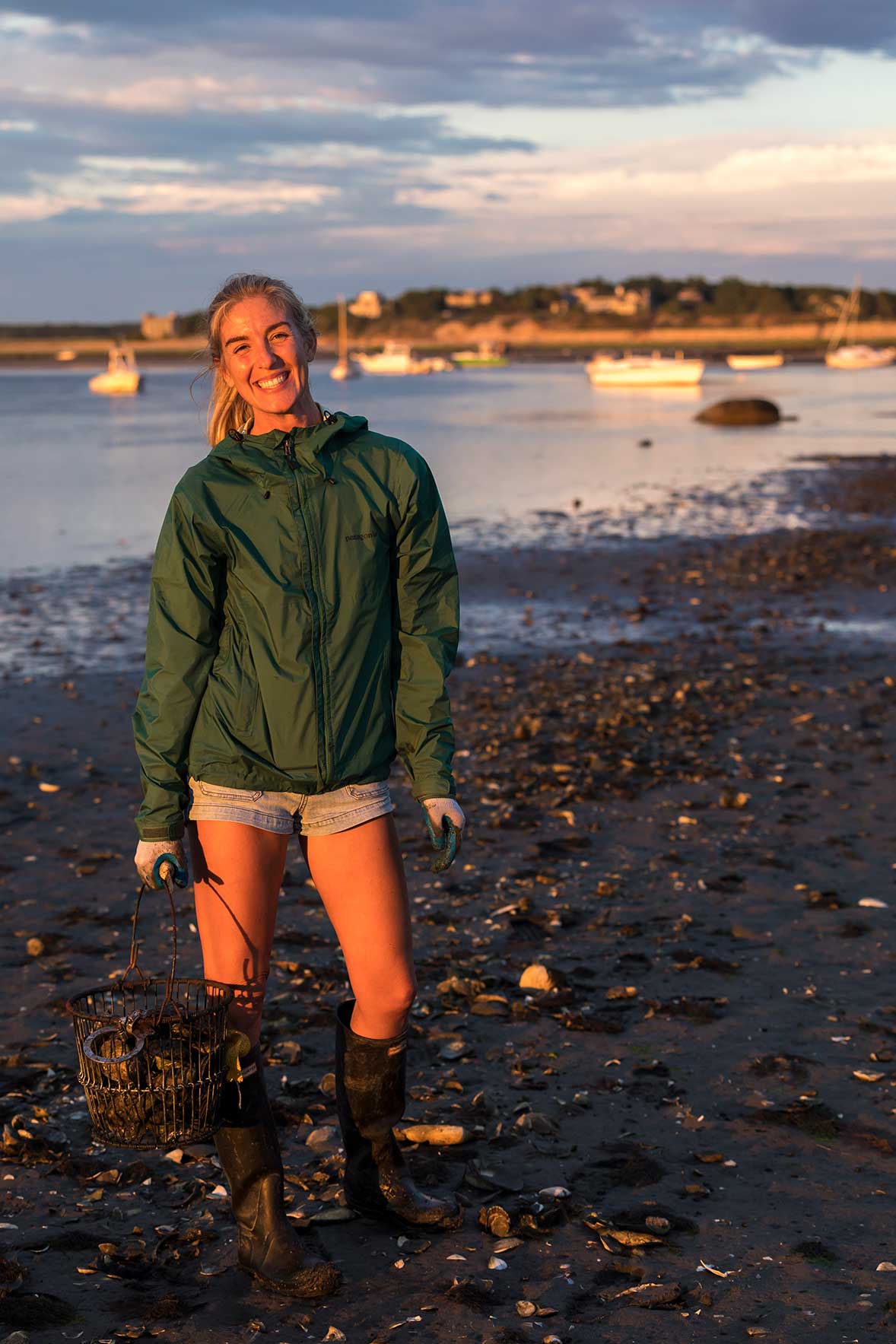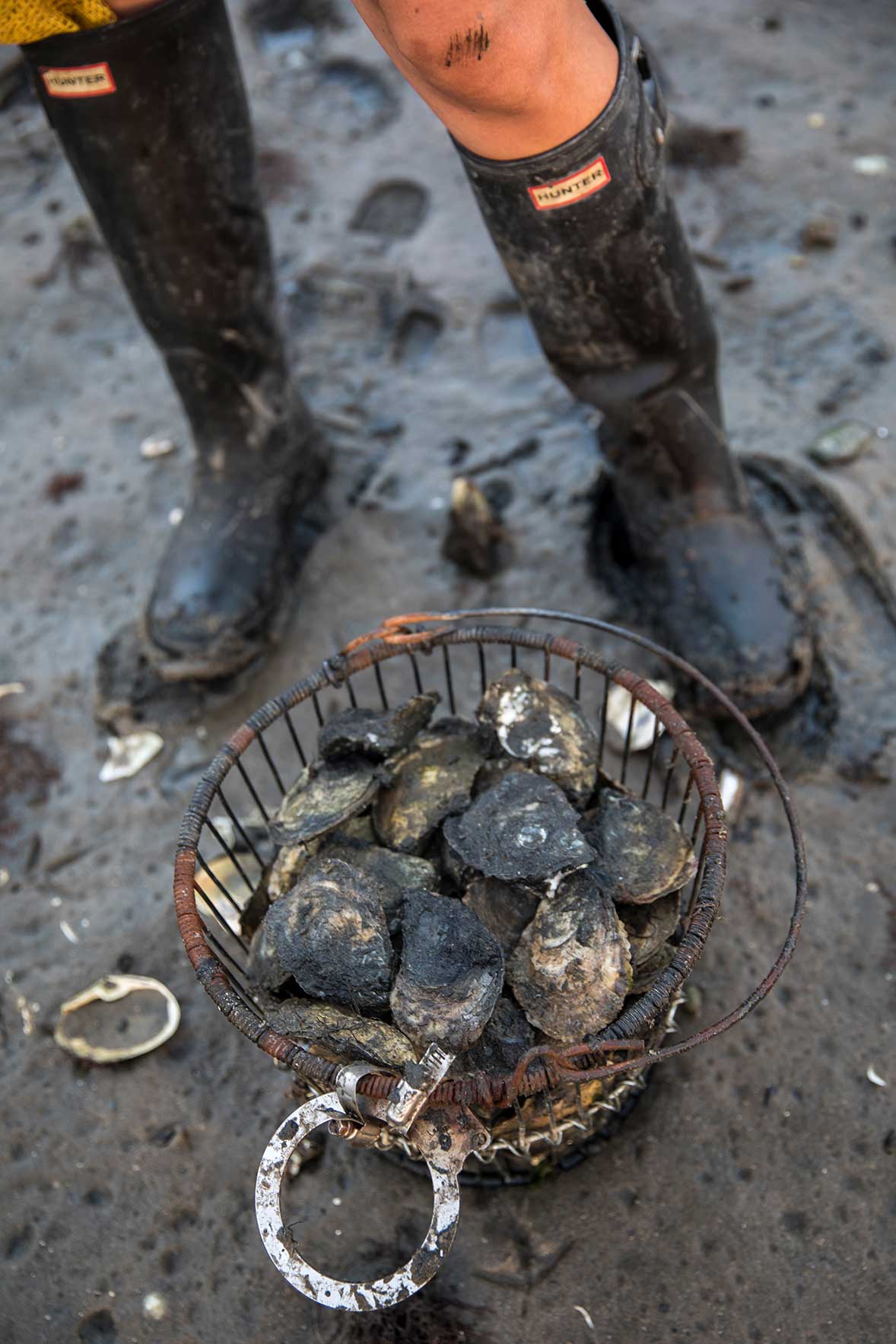Despite Harsh Conditions and Wavering Markets, Three Female Entrepreneurs Find Freedom and Adventure in Their Careers as Oyster Harvesters.
by Lisa Cavanaugh
Photographs by Julia Cumes
A wild Wellfleet oyster (crassostrea virginica) begins its life as a free-floating larva. It wafts through the cold and salty waters of Wellfleet harbor and its estuaries before settling on a suitable solid surface, such as a rock, piling, or old shell. There it grows for the rest of its life, perhaps spawning new seed if the conditions are right, until it is ready to be plucked from its aqueous home by another rare breed, a wild oyster harvester.
History shows that Wellfleet’s sheltered harbor has been ideal for oyster harvesting for centuries. Native populations regularly harvested wild oysters for food. In 1606, French explorer Samuel de Champlain surveyed the area and named it “Port Aux Huitres” or “Oyster Port.” In the late 17th century, shellfishing drove the economies of early European settlements, and by the late 18th century, the Wellfleet oyster was already being overfished as well as severely impacted by naturally occurring disease. An initial community effort in the early 1800s to reseed the harbor’s estuaries launched the town’s ongoing aquaculture efforts. Wellfleet currently oversees close to one hundred shellfish farms, the most of any town in the Commonwealth, and in 2020 the town’s Shellfish Department issued 175 permits to wild harvesters.
“It isn’t for everybody,” says Wellfleet Shellfish Constable Nancy Civetta, of the wild fishery. “The job is physically demanding, and you work in all kinds of conditions. You live by the tides, you live by the weather, and you need to know where you are going and what you are doing.” While the majority of wild harvesters are men, there are women who have been working on the flats for decades and female rookies join the industry each year. “As a woman, seeing a number of other women recently entering the fishery was a joy,” says Civetta.
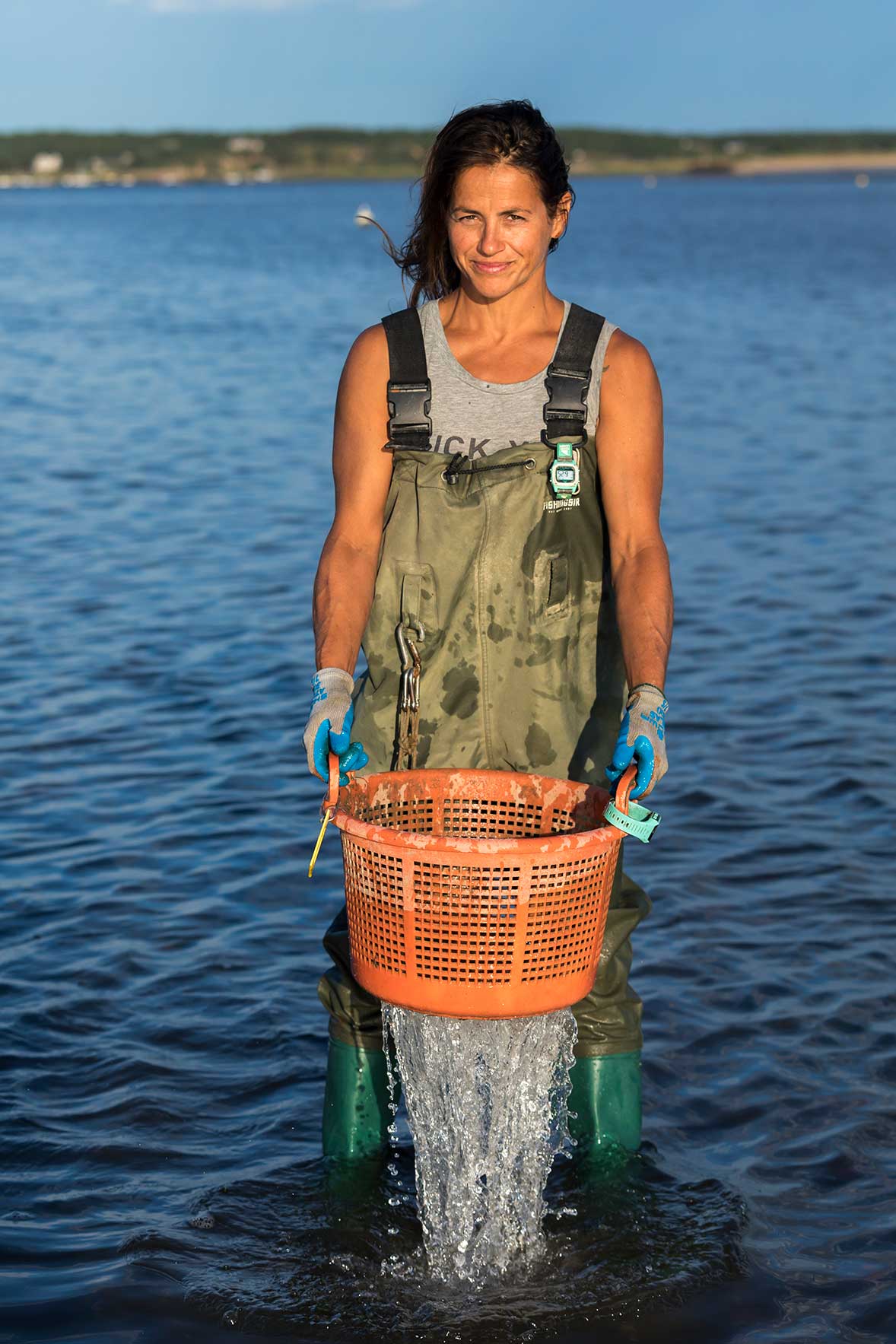
For three local women, both the challenges and the rewards were what drew them to this exacting occupation. “Every day is an adventure and everything is constantly shifting,” says Sonya Woodman, who began wild harvesting two years ago, after several seasons working for shellfish farmers. “I remember walking out to a grant one night under a full moon. We were making our way through the waves in the darkness, with just the moonlight shining on the water. The way it made me feel was amazing, and I decided then to try wild picking.”
Embracing every aspect of her new vocation, Woodman shrugged off any suggestion that the work might be too tough for a woman. “I was told that it would be too cold, too wet, that oysters would be too heavy for me,” she says. “But I’m pretty athletic and strong and there are wise ways to solve any problem.” Woodman invested in some unique equipment to creatively address wild-harvesting obstacles. She uses a specialized beach cart with big wheels to move her harvest, and also bought a floating creek cooler that looks like a mini kayak, so she can safely ice her oysters and keep picking in the summer heat. “It’s all about strategy. You have to go out there with a plan.”
Woodman, who grew up fishing on ponds, is also a surfer and feels particularly drawn to water. “I enjoy everything about it, the whole process.” She relishes being able to work outside and connect with nature, especially as someone who previously worked in the restaurant business. “Now my work is one hundred percent wild harvesting, and I love the freedom of it. You are out on a spot, paying attention to the tide and the wind, following your instincts and looking for tiny details that will lead you to shellfish. Sometimes the oysters are under things, and you see just a slight edge, a little bit of white poking out of the sand. It’s exciting.”
A background in fishing also led another wild harvester, Melissa Yow, to the flats of Wellfleet. “I grew up near the ocean, and fishing has always been in my blood,” she says. “As a kid I loved to fish with rod and reel, dig clams by hand, and catch crabs in the rocks. I still run around with my fishing rod, and more recently fish on the back deck of commercial boats, so it felt natural to fish for shellfish by foot.” Yow worked in aquaculture for several years both at a hatchery and for other growers before she was given the opportunity to branch out on her own. “I just started my own oyster farm this year, which is exciting. I think it will be complementary for me to farm as well as wild harvest.”
While having the flexibility to offer both a farmed and wild product allows Yow to adapt to a fluctuating market, she finds the wild fishery to be a very unique occupation that appeals to gritty people who love independence. “I think it’s empowering,” says Yow, who digs for quahogs as well as oysters. “I enjoy playing the tides, picking and choosing where to fish based on my own initiative and the moon, weather, and wind.” She recalls the first time she found a “honey hole” full of littleneck clams. “I was off by myself with no one in sight, hunting around in the grass, when I found it. I felt like I was on top of the world!”
Yow explains that there are also times where her patience is truly tested. “But I have to remember that it’s days like that which make the more successful days so good,” she says.
“This is the essence of fishing, and why I love it.”
Falling in love with shellfishing was equally as easy for Melissa Lynch, who with her husband Justin, wild harvests for oysters and clams while also farming a deep-water grant. “I’m not from Cape Cod,” says Lynch, who hails from the Berkshire region of Massachusetts, “but I moved here four years ago because my husband is a native Wellfleetian.” Lynch was a career academic with a master’s in foreign language when her husband, who has been fishing for over twenty years, gifted her a commercial license for Christmas one year. “Every day is different, and you have to find your own rhythm and groove. I really fell in love with the lifestyle and even though I never realized this would become my occupation, it is the best move I could have made, for myself personally and for my family.”
Lynch and her husband have a five-year-old son, River, who has been joining his parents both at their grant and during wild harvesting since he was three. “It’s wonderful to have a grant and get to work it together and to also bring him wild picking with us. He loves digging for clams and is very comfortable on the flats.” Being able to include their son in her work was a driving force behind Lynch’s momentous career switch. “We get to be together on a daily basis and maximize our family time. It’s a beautiful lifestyle.”
The Lynches typically try to spend some time during the off-season traveling each year, and this past winter they visited Justin’s mother’s home on the island of Maui for a couple of months. In early March, they were returning to what they believed would be another busy spring and summer when the pandemic hit. “We flew into Boston just as this part of the world was starting to shut down,” says Lynch. “We arrived home to a closed shellfish market.” They had to get creative because many of the distribution channels that supply restaurants with fresh Wellfleet oysters and clams closed. “We are fortunate that we have great personal accounts that kept us afloat,” says Lynch, “and I’m so grateful that our distributors were able to move our shellfish.”
The market shutdown also affected Woodman and Yow, who each found ways to adapt. “I went from having several buyers calling for oysters to everything shutting down,” says Woodman, who says she was lucky to find one buyer with whom she has been working since May. “The volume went down and along with that was a reduction in price, but in this environment I was really happy to be able to keep working.”
“I was digging clams on double tides every day,” says Yow, who finds that the clam market is often more stable, perhaps because they are more easily prepared by home chefs. “Not everyone knows how to shuck an oyster,” she says, “and the restaurants were all closed at the start. So clams have been my saving grace through these times.”
With shellfishing being so critical to Wellfleet’s economic stability (25 percent of the town’s working age population makes their living in the shellfish industry), a local nonprofit stepped in to support the men and women who work the flats. “When the pandemic hit and restaurants and distributors closed, our shellfishermen lost their source of income overnight,” says Michele Insley, executive director of Wellfleet SPAT (Shellfish Promotion and Tasting Inc.), “We immediately realized that we had to help, so we developed a three-part Wellfleet Shellfish Harvesters Relief Program.”
The projects included a community food share system, in which SPAT purchased shellfish from harvesters, and through established distribution channels donated it to food pantries. SPAT also allocated funds to help with basic living expenses and built upon a low-interest loan program that had been started in 2015. “Wellfleet has a long tradition of shellfishing, with what I believe to be the best oyster product in the world,” says Insley. “Shellfishing is critical to not only our local economy, but to the state’s as well.” Insley cites an impressive statistic, echoed by Civetta: in 2019 the town of Wellfleet was number one in Massachusetts for shellfish landing value (of all species and from both wild harvesting and aquaculture) to the tune of $7.7 million.
That is just one of the reasons why the town actively bolsters sustainable shellfishing. “Over the past few years we have purposefully and thoughtfully been increasing our propagation program,” says Civetta. “We buy field plant oyster and quahog seeds from hatcheries and maintain our nursery bed to grow out predator resistant-sized juvenile shellfish to broadcast them to areas of the harbor where they can finish growing.” The shellfish department also has set up a revolving fund in which 75 percent of all revenues from permit sales and aquaculture grant licensees goes into nursery efforts, and has managed a seed donation program where local shellfish farmers can gift “hat seed,” (oyster seed collected from the wild) toward the wild fishery. The town has even invested in their own spat-collecting devices to use in the harbor for attracting wildly spawned larvae.
Every one of these women who interact in some way with the wild shellfish of Wellfleet feels lucky that her town is blessed with this unique natural phenomenon. “I can’t say exactly why we have such an amazing natural reproduction, especially of oysters,” says Civetta.
“I have heard that it could be because of the way the tide currents move or prevailing southwest winds keep the larvae in our harbor. Whatever it is, we will continue our propagation efforts in order to create a sustainable future for our shellfishery.”
Any effort to keep the fishery strong pleases the women of the wild harvest. “The fishery is not always reliable,” says Yow. “So you have to be willing to stick it out through tough times.” Lynch agrees that you need to have endurance, both physically and mentally. “I have the utmost respect for the people who have been doing it for so long,” she says, “And now I am committed to this life as well.”
“It can be hot, it can be cold. There is ice, mud, the rising tide,” says Woodman. “You have to have patience, but you also have to move fast, so there are days when it is stressful for sure.” She then recalls moments when she has been out on the flats, not finding anything, when all of sudden she discovers shellfish treasure. “Those days make it all worthwhile, and I’m just so happy that I’m wild picking.”
Where to Find Wellfleet Oysters
Even though the world-famous Wellfleet Oyster Festival will be online this year, there are still are many opportunities for tasting both wild-harvested and farmed Wellfleet oysters (and other shellfish):
Billingsgate Shellfish Billingsgate Shellfish offers free home delivery of oysters and clams from Brewster to Provincetown. $30 minimum order. Cash or Venmo payment. To order, call or text, 774-722-1440. billingsgateshellfish.com
Holbrook Oyster
Holbrook Oyster organizes free home delivery of oysters, clams, and scallops from Provincetown to Harwich. The company also offers pickup at 4380 State Highway in Eastham on select days, and they will arrange meet-ups for deliveries in Orleans for shellfish lovers who are further away. Check their website for specific days and times and to order, call or text 508-237-6929. $20 minimum order. Cash or PayPal payment. If your kitchen isn’t outfitted for shucking, Holbrook Oyster sells custom knives as well. holbrookoyster.com
Mac’s Kitchen
A variety of super-fresh fish and shellfish, house-smoked seafood, and patés are available at Mac’s Kitchen. Curbside pick-up. Open seasonally until 6 p.m. To order, call 508-255-6900. macsseafood.com
Wellfleet Shellfish Company
Do you know someone who is homesick for the coast? Wellfleet Shellfish Company will ship Wellfleet oysters and locally harvested clams, scallops, and lobsters to anywhere in the U.S.
To order, visit wellfleetshell.com or call 508-255-5300.
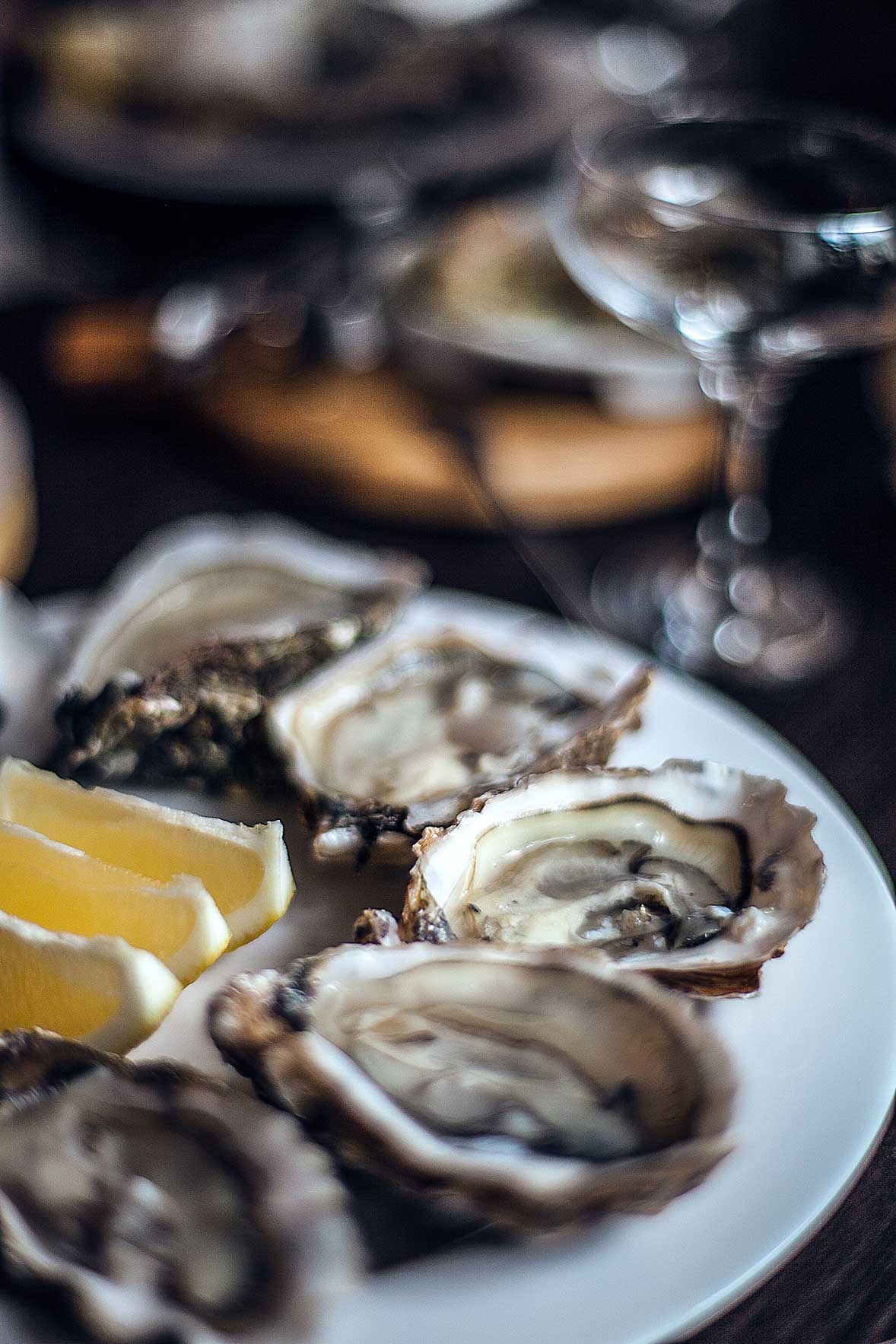

If you are elsewhere on the Cape, Martha’s Vineyard or Nantucket and want to sample micro-local shellfish, these oyster companies offer curbside pick up, delivery, and shipping.
Chatham
Chatham Oysters offers pick up at The Shanty at 393 Barn Hill Road Chatham and Overnight Delivery nationwide via FedEx. For more information and to order, visit chathamoysters.com.
Cotuit
At Cotuit Oysters, customers can get a “Mini Raw Bar To-Go,” which contains 24 oysters and 12 littlenecks. The company also offers the Littleneck and Oyster Combo Pack with two dozen of each. To order, email retail@cotuitoystercompany.com or visit the website cotuitoystercompany.com.
Dennis
The East Dennis Oyster Farm is open for curbside, non-contact pickup of fresh oysters from its store in South Dennis. Call 508-398-3123 or get more information at dennisoysters.com.
Falmouth
Coonamessett Farm in Falmouth has Sippewissett Oysters available for pickup. The farmers harvest on demand year-round, so call ahead to place your order (508-563-2560). Learn more about these oysters grown by member farms of the Falmouth Shellfish Cooperative online at sippewissettoysters.com.
Oak Bluffs
Cottage City Oysters are open-ocean farmed in the crisp waters of Vineyard Sound, off Oak Bluffs on Martha’s Vineyard. Martino’s Seafood delivers these oysters, littlenecks, sea scallops, and seaweed twice weekly, on-island only. Find more information at cottagecityoysters.com.

